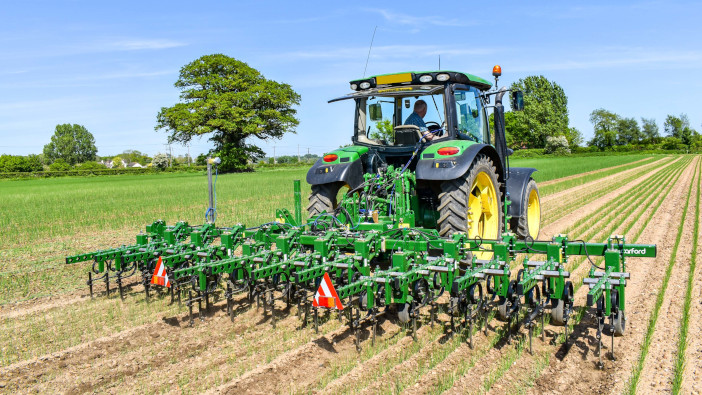According to new research conducted by NIAB, a combined approach to weed control can help to reduce reliance on chemical inputs. Non-chemical approaches, including mechanical hoes, have the potential to offset herbicide resistance and reduce reliance on chemical plant protection in conventional cropping.
The results are part of an EU-funded Horizon integrated weed management project, with research undertaken by NIAB research agronomist Will Smith, alongside weed biology and management specialist John Cussans. The project looked at different methods of weed control, specifically control of blackgrass in winter wheat.
Their ultimate aim was to look at ways to reduce herbicide usage in line with impending controls on the use of pre-emergence products and chemical applications, balanced with the EU-wide policy to reduce usage by 50% by 2030. While these do not directly impact the UK, similar targets are anticipated in this country, as continued usage could impact trade with member states.
“Development in the weed control sector is going to be led by non-chemical solutions,” said Mr Smith. “This means consideration of cultural, non-chemical and biological pathways. We also need to look at continued herbicide development, particularly the potential to offset resistance.”
Cultural factors include crop rotation, crop choice and drilling dates, while biological solutions include biocides and biostimulants, as well as non-synthetic herbicides such as organic acids. Particularly interesting to the project was inter-row hoeing, enabling more aggressive cultivation which can remove more established weeds.
Using a Garford Farm Machinery Robocrop hoeing unit, the project found that there was an additional 15% control of blackgrass heads when mechanical weeding was added to a herbicide programme when working in narrow rows. The efficacy was doubled on wider rows.
“Inter-row cultivation adds an appreciable level of control of between 15-25% when combined with herbicides,” explained Mr Smith. “The sweet spot of course is to use IRC in combination with reduced chemical inputs to meet the reduction targets.”
Looking at the margins, the research found that a combination of inter-row hoeing and herbicides is comparable to just using chemical controls, while in low pressure areas, the use of just an inter-row hoe may be preferential. Mr Smith added that the key is changing mindsets, as many conventional growers do not consider mechanical weeding as a viable option.
“What our research indicates is that growers can achieve at least the same or marginally better margins over weed control than currently used methods, with the scope to deliver effective weed control while reducing reliance on chemical solutions,” he said.
Crucially, even if new equipment is purchased to handle mechanical weeding, the additional costings have been calculated at £15 per hectare, based on two passes. Larger scale operations may even see this drop to below £10.
“The research demonstrates the benefits of integrating our range of precision-guided hoes in broadacre arable crops, for both conventional and organic systems,” said Allan Knight, Garford Farm Machinery technical sales and marketing manager.
As agrochemicals are withdrawn from the market, more and more conventional farmers are beginning to appreciate hoes as a more appropriate solution, in combination with other weed controls.
“While previously non-chemical approaches have been seen as an expensive add-on to conventional herbicide programmes, the addition of mechanical weed control products as part of an integrated weed management system offers a cost-effective and sustainable solution to growers,” he concluded.
For more information go to www.garford.com



